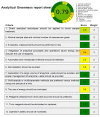Determination of Thymol in Commercial Formulation, Essential Oils, Traditional, and Ultrasound-Based Extracts of Thymus vulgaris and Origanum vulgare Using a Greener HPTLC Approach
- PMID: 35208963
- PMCID: PMC8879744
- DOI: 10.3390/molecules27041164
Determination of Thymol in Commercial Formulation, Essential Oils, Traditional, and Ultrasound-Based Extracts of Thymus vulgaris and Origanum vulgare Using a Greener HPTLC Approach
Abstract
In the literature, greener analytical approaches for determining thymol in its commercial formulations, plant-based phytopharmaceuticals, and biological fluids are scarce. As a result, the goal of this study is to develop and validate a normal-phase "high-performance thin-layer chromatography (HPTLC)" method for determining thymol in commercial formulations, essential oils, traditional extracts (TE), and ultrasound-based extracts (UBE) of Thymus vulgaris and Origanum vulgare obtained from various geographical regions. The greener mobile phase for thymol analysis was a binary combination of cyclohexane and ethyl acetate (85:15, v/v). The derivatized densitometric analysis of thymol was carried out under visible mode at 530 nm utilizing anisaldehyde-sulfuric acid as a derivatizing/visualizing agent. In the 10-2000 ng/band range, the greener normal-phase HPTLC method was linear. Furthermore, for thymol analysis, the proposed analytical approach was simple, quick, inexpensive, accurate, precise, robust, sensitive, and greener. The thymol contents in commercial formulation were computed as 7.61% w/w. In general, the thymol contents were maximum in essential oils of T. vulgaris and O. vulgare compared to the other sample matrices studied. The thymol contents of TE of T. vulgaris and O. vulgare of different geographical regions were significantly low compared to their UBE extract. Using 12 distinct components of green analytical chemistry, the overall "analytical GREEnness (AGREE)" scale for the proposed analytical approach was computed 0.79, showing the good greener nature of the proposed analytical approach. Overall, the greener normal-phase HPTLC technique was found to be reliable for determining thymol in commercial formulations and plant-based phytopharmaceuticals.
Keywords: AGREE scale; essential oils; greener HPTLC; thymol; ultarsonication; validation.
Conflict of interest statement
The authors declare no conflict of interest.
Figures








References
-
- Khan S.T., Khan M., Ahmad J., Wahab R., Abd-Elkader O.H., Musarrat J., Alkhathlan H.Z., Al-Kedhairy A.A. Thymol and carvacrol induce autolysis, stress, growth inhibition and reduce the biofilm formation by Streptococcus mutans. AMB Express. 2017;7:49. doi: 10.1186/s13568-017-0344-y. - DOI - PMC - PubMed
-
- Grulova D., Caputo L., Elshafie H.S., Baranova B., De Martino L., Sedlak V., Gogalova Z., Poracova J., Camele I., De Feo V. Thymol chemotype Origanum vulgare L. essential oil as a potential selective bio-based herbicide on monocot plant species. Molecules. 2020;25:595. doi: 10.3390/molecules25030595. - DOI - PMC - PubMed
MeSH terms
Substances
Grants and funding
LinkOut - more resources
Full Text Sources
Research Materials

